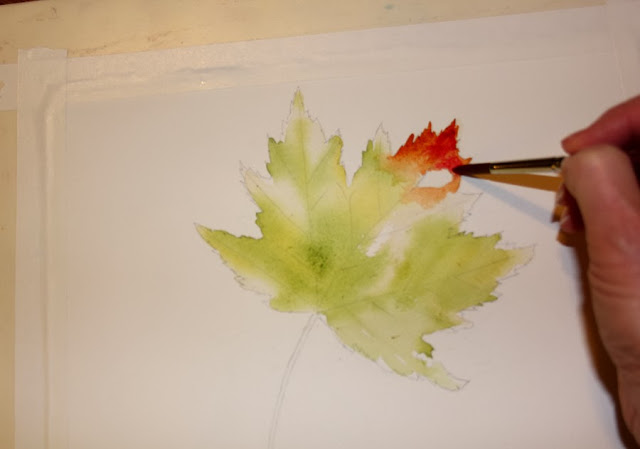This spectacular display is due to the interplay of pigments found in leaves. As temperatures drop, trees stop producing chlorophyll, the pigment responsible for the green color of leaves. This enables the other color pigments to shine through.
Autumn leaves are varigated in color as this change takes place and that makes it fun to paint them! Go for a walk and notice the leaves and how they are changing. Ours have just started to change in east Tennessee because we've just had our first few near freezing nights. Pick up a few leaves as you walk and bring them inside and let's paint!
Select a leaf and either trace around the edges with your pencil or draw it on a piece of watercolor paper.
Mix up juicy puddles of the colors that you see in your leaf. In the leaf I selected, I see green, red and rust. To make my green, I mix up a generous puddle of DaVinci arylide yellow and another puddle of WN phthalo blue near it to mix my green. The other colors are WN Alizarin Crimson and WN Burnt Sienna for my red and rust.
There are many ways to paint a leaf. In this post, I show you one way.
I wet the surface of my leaf sketch with water and paint it with my lightest color--in my case it is green-- leaving some areas unpainted. Since leaves are varied in how their pigments change in the fall, I am only using the leaf I found as a reference for ideas and am not concerned with the final result looking exactly the same as the leaf.
Next, I drop some red and rust into the tips of the leaf, letting the two colors blend as I do this. The damp surface of the leaf carries the pigment into other areas also.
When the surface of the paper becomes too dry, I rinse my brush and re-wet the surface again with clear water so that the water can carry the pigment beyond where I am painting. As the wet pigment overlaps the dried green areas, I have created a glaze that will dry and show the green underneath.
When the pigment touches a wet surface it spreads and mixes with the wet color beside it. In the image above, the edge of my red pigment at the bottom left has stopped on the dry surface leaving a hard edge.
I want that edge to be soft or blend softly into the next color, so I wet my brush, blot it to remove excess water, and brush that edge with water to soften it.
These hard edges will appear whenever the surface has dried, stopping the flow of pigment. Whenever this happens, wet your brush, blot the excess water on a sponge or paper towel, and brush across that edge while the paint is still wet so that the pigment spreads into the damp surface and ends in a softened edge. Another way to do this--when you notice the surface has dried, dampen it with clear water before applying the next brush of color. This keeps the pigment spreading as you work.

Below I've added some dark spots (sepia mixed with burnt sienna) and some splatter. Have fun with it!
Next: Fun with Fall Leaves--Wet-in-Wet on Dry Paper
Fun with Fall Leaves series
More posts on wet-in-wetThe science of color in fall leaves

























Thank you so much for this wonderful tutorial! Can't wait to try this!!
ReplyDeleteThanks, Starr. Let me know how it goes!
ReplyDeleteYour tutorial felt like I was participating in one of my girls' art lesson when they were little. I will be coming back to your tutorial next week with supplies in hand. Found your blog through Sketching in Nature. Your work is beautiful.
ReplyDeleteWelcome, Lisa! Thank you! I hope the "girls' art lesson" similarity means the information was easy to follow! Let me know how your practice turns out.
ReplyDelete